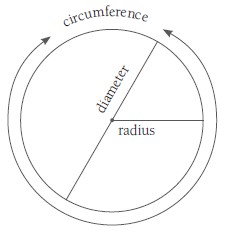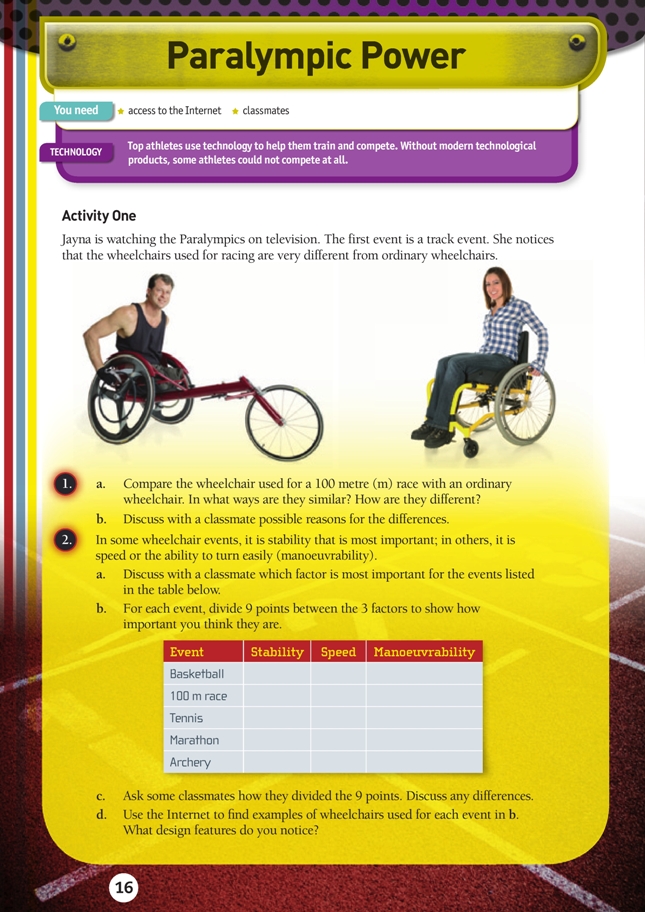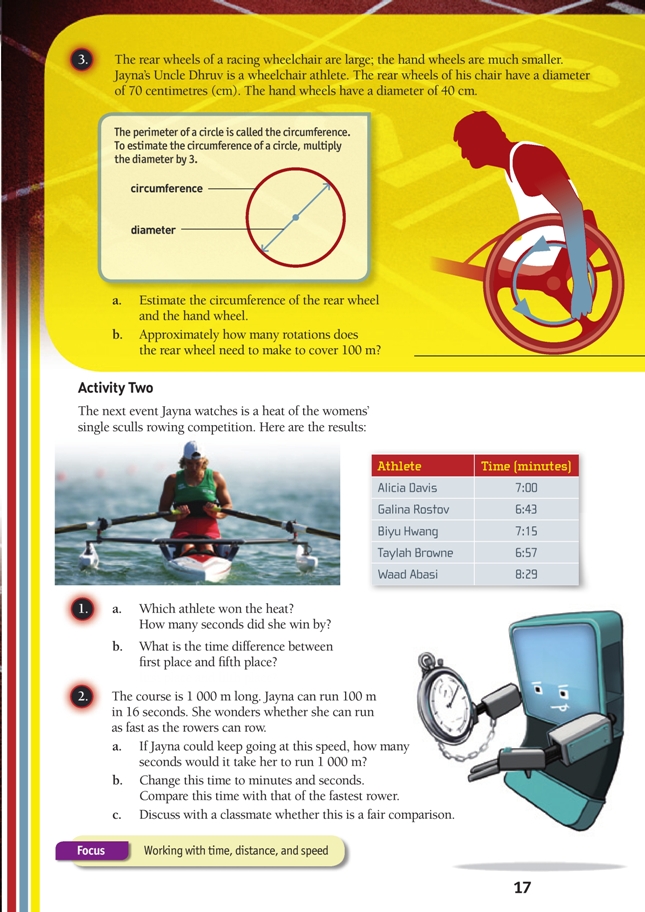This is a level 4 activity from the Figure It Out series.
A PDF of the student activity is included.
Click on the image to enlarge it. Click again to close. Download PDF (886 KB)
Mathematics is the science of patterns and relationships. Mathematical relationships are often described using formulae. Mathematicians explored the relationship between a circle’s circumference and its diameter for hundreds of years before identifying a precise relationship (C = πd).
In these activities, students use an approximation of this relationship. They use another type of relationship (rates) to compare the speed of a runner with that of a rower.
classmates
FIO, Technology in Practice, Levels 3+-4+, Paralympic Power, pages 16 - 17
Activity One
Students are asked to quantify their perception of the relative importance of three factors in wheelchair sports. Quantifying perceptions by using ratings or rankings is a common statistical approach. It is simpler to analyse numerical data than qualitative or descriptive data. Working with numbers makes it easier to draw comparisons between people’s perceptions. Rating or ranking objects can also be a useful way for people to evaluate their own perceptions.
A problem arises when a person believes that two items are equivalent. Rankings may force them to differentiate between the two items unless they are given the option of equal rankings. In this example, if a student believes that a wheelchair deserves 4 out of 9 points for speed, it is not clear whether they can divide the remaining 5 points equally between the other 2 factors. 
Before beginning question 3, introduce the language of circle geometry. The radius is a line from the middle of the circle to the circumference. The diameter is the width of the circle.
The circumference of a circle is found using the formula: circumference = π x diameter. Using formulae and working with the number π x (pi) are appropriate for students working at level 5 of the curriculum. However, students at levels 3 and 4 can and should explore the relationship between diameter and circumference:
- Regardless of the size of the circle, dividing the circumference by the diameter always gives the same number, known as π (pi). π is an “irrational number” because it can’t be written as a simple fraction. This special number has fascinated mathematicians for nearly 4 000 years. The value of π is approximately 3.14, but at levels 3 and 4, it is sufficient for students to know that the circumference of a circle is roughly three times its diameter.
- If the school playground has a large painted circle, ask the students to count the number of paces they use to walk around the circumference of the circle and the number they use to walk across its diameter. Compare the results as a class. The number of paces for the circumference should be approximately three times the number for the diameter.
- Provide students with circular objects, such as cans, hula-hoops, saucepan lids, and plates, and several pieces of string. Working in pairs, have the students wrap string around their object, cutting it so that it is the same length as the circumference. Then ask them to stretch the string over the diameter of the circle, making sure that it is both fl at and straight. The students should cut as many diameters as they can from the circumference string. By comparing results with their classmates, they will see that the circumference of a circle is always slightly more than three times the diameter.
The same activity can be adapted to provide measurement practice. Ask the students to measure the length of a piece of string wrapped around a circular object and to measure the diameter of the object using a ruler.
In question 3, students use an approximation of π to estimate the number of rotations the rear wheel of the wheelchair makes. Introduce students to the symbol used to show an approximate answer (≈). Discuss the difference between this symbol and the = sign. Many students perceive the = sign as a command to carry out the operation that comes before it. This can result in run-on sentences that are mathematically incorrect. For example, a student calculating 2 + 7 and then multiplying the result by 3 may write this as 2 + 7 = 9 x 3 = 27. The true meaning of = is “is the same as”. Understanding the = sign is important for mathematical reasoning.
Interpreting and using mathematical symbols develops the key competency using language, symbols, and texts.
Activity Two
Students often treat recorded times as if they were decimals. Discuss with the students that 6:43 represents 6 minutes and 43 seconds, not 6.43 minutes, and explain the difference between the two. The two values would only be equivalent if there were 100 seconds in a minute. However, the principles used to order decimal numbers still apply. For example, the athletes can be ranked from first to fifth by looking first at the number of minutes and then at the number of seconds.
Because time is seldom written as a decimal, students should avoid using their calculators to find differences in time. Encourage them to adapt their number strategies, for example, by using “tidy numbers” but making numbers up to 60 instead of 100.
Comparing Jayna’s time to the rowers’ times involves proportional reasoning. Students need to consider whether the rate Jayna runs will remain constant. Without this constancy, the comparison between her speed and that of the rowers is unfair.
Technology-related student activities
- Discuss the difference between “performance-enhancing” sports-related technologies and “essential for performance” technologies.
- Debate whether athletes with disabilities should be allowed to use technology to compete against able-bodied athletes.
Exploring the technology-related context
Assistive or adaptive technology is the development of products and systems useful for people with disabilities. Some assistive devices relate to everyday life; others have specialist applications, such as on the sports field. Some paralympians use technology that is similar to that used by able-bodied athletes and others use technological products that have been uniquely modified to meet their needs.
Answers
Activity One
1. a. Similarities: Both wheelchairs have big back wheels. Differences: The racing wheelchair only has 3 wheels. It has doesn’t have footrests, armrests, or a back, and its front wheel extends out a long way. The back wheels of the racing chair slope inwards. The hand wheel of the racing wheelchair is much smaller.
b. The racing chair is designed for speed and for racing tracks that have no tight curves. A normal wheelchair needs to be able to turn easily.
2. a–c. Answers will vary. Manoeuvrability and speed are important in basketball, and speed in a 100 m race and a marathon. Stability is essential for archery. It could be argued that tennis players need all three in equal measure.
d. Practical activity
3. a. Circumference of rear wheel ≈ 3 x 70 = 210 cm. The circumference of hand wheel ≈ 3 x 40 = 120 cm.
b. About 50. (210 cm ≈ 2 m. 2 m x 50 = 100 m, so about 50 rotations.)
Activity Two
1. a. Galina Rostov won by 14 s.
b. 1 min 46 s (17 s + 29 s + 1 min)
2. a. 160 s
b. 2 min 40 s, which is a lot faster than the fastest rower
c. It’s not a fair comparison. Jayna can run fast for 100 m, but she wouldn’t be able to keep running at this speed if she had to run 1 000 m. However, if Jayna runs 100 m in 16 s, she will have 6:27 min (387 s) to complete the remaining 900 m. If Jayna can run at an average speed of 100 m / 43 s for 900 m, she will have travelled faster than the rowers.

